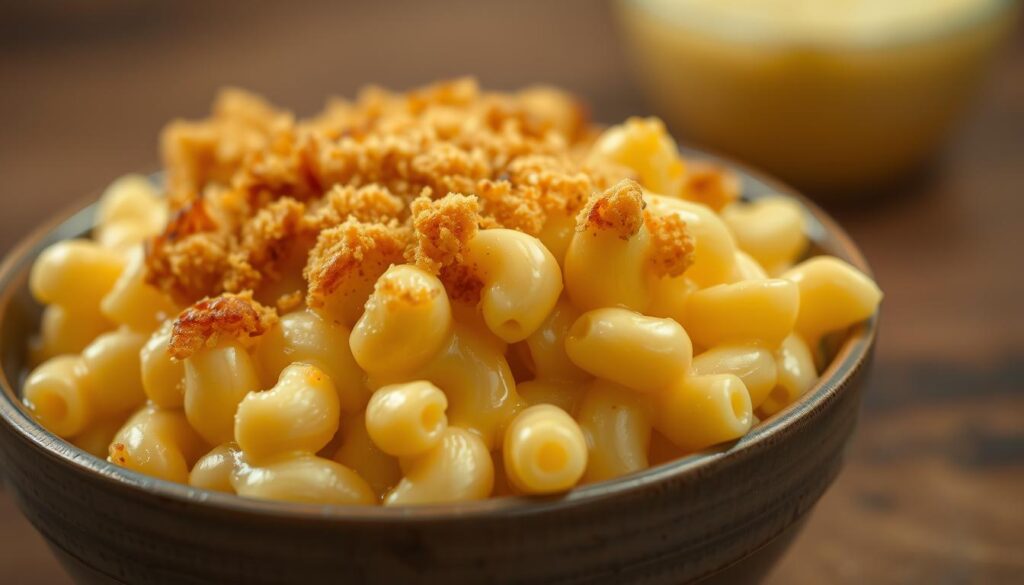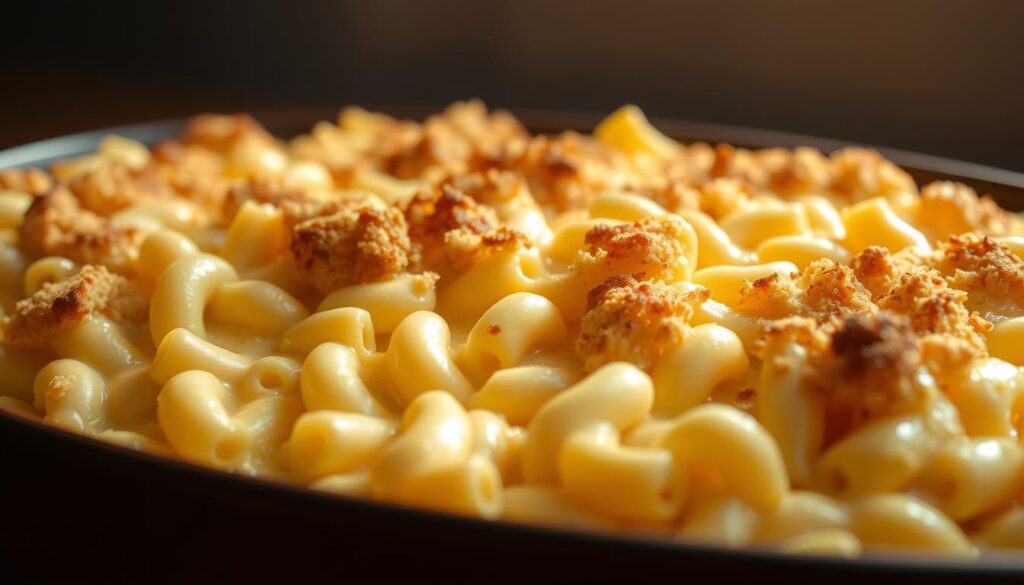There’s something undeniably comforting about a warm, creamy mac dish straight from the oven. The combination of a crispy top and a rich, cheesy interior is a match made in heaven. This beloved comfort food is a staple for many, and for good reason – it’s the perfect remedy for a chilly evening or a family gathering.
Our take on this classic dish promises to deliver on all fronts: a satisfying crunch giving way to a velvety, cheesy centre. It’s a simple yet indulgent recipe that’s sure to become a favourite in your household.
Key Takeaways
- Easy-to-follow recipe for a classic comfort food
- Achieve the perfect balance of crispy and creamy textures
- Customisable to suit your taste preferences
- Perfect for family gatherings or a cosy night in
- Satisfies your cravings with a rich, cheesy flavour
The Rich History of Mac & Cheese: From Royal Tables to Modern Comfort Food
The history of mac & cheese is a fascinating tale of culinary evolution, from royal tables to modern comfort food. This beloved dish has traversed centuries, transforming from a humble European recipe to an American classic.
Origins in European Cuisine
The origins of macaroni and cheese can be traced back to European cuisine, specifically to the medieval Italian and French culinary traditions. The earliest recorded recipe for a pasta and cheese dish dates back to the 14th century in Italy. “Liber de Coquina,” an Italian cookbook from that era, contains a recipe for “de lasanis,” a dish made with layers of pasta, cheese, and spices.
Similarly, in France, a dish called “macarons au gratin” was popular among the aristocracy in the 16th century. This rich and creamy dish was considered a delicacy and was often served at banquets and feasts.

| Region | Dish | Century |
|---|---|---|
| Italy | de lasanis | 14th |
| France | macaronis au gratin | 16th |
Evolution into an American Classic
Mac & cheese made its way to America in the 18th century, where it became a staple of American comfort food. The first American recipe for macaroni and cheese was published in 1824 by Mary Randolph in her cookbook, The Virginia House-Wife. This recipe included a bechamel sauce, macaroni, and a mixture of Parmesan and Cheddar cheese.
Over time, mac & cheese evolved to incorporate local ingredients and preferences, becoming a beloved dish across the United States. Its popularity soared during the Great Depression, as it was an affordable and filling meal option.
Why Homemade Cheesy Baked Mac & Cheese Beats Store-Bought Every Time
Homemade cheesy baked mac & cheese offers a depth of flavour and quality that store-bought alternatives simply can’t match. The difference lies in several key areas that make the homemade version a superior choice for comfort food lovers.
Superior Flavour Profile
The flavour profile of homemade mac & cheese is rich and complex, thanks to the use of high-quality ingredients and a carefully crafted cooking process. Unlike store-bought versions, which often rely on preservatives and artificial flavour enhancers, homemade mac & cheese is made with real cheese, pasta, and seasonings, resulting in a more satisfying taste experience.

Control Over Ingredients and Quality
When you make mac & cheese from scratch, you have complete control over the ingredients and their quality. This means you can choose the best cheeses, fresh pasta, and other ingredients to create a dish that is not only delicious but also tailored to your dietary preferences. In contrast, store-bought mac & cheese often contains processed ingredients and preservatives that can compromise flavour and nutritional value.
Customisation Possibilities
Another significant advantage of homemade mac & cheese is the customization it offers. You can experiment with different types of cheese, add-ins like vegetables or proteins, and various seasonings to create a unique flavour profile that suits your taste. This flexibility is not available with store-bought versions, which are limited to their pre-formulated recipes.
In summary, the homemade version of cheesy baked mac & cheese stands out due to its superior flavour, control over ingredients, and customisation possibilities, making it a more satisfying and enjoyable meal compared to store-bought alternatives.
Essential Ingredients for the Perfect Homemade Cheesy Baked Mac & Cheese
The foundation of a great homemade cheesy baked mac & cheese lies in its ingredients. To create a dish that’s both creamy and crispy, you’ll need to select the right components.
Choosing the Right Pasta
Selecting the appropriate pasta is crucial for mac & cheese. Macaroni is the traditional choice, but other short pasta shapes like shells or elbows can also work well. The key is to choose a shape that holds onto the cheese sauce effectively.
Cheese Selection Guide
The cheese is the star of mac & cheese. A blend of cheeses usually works best, providing a balance of flavour and texture.
Best Cheeses Available in Pakistan
In India, you can easily find cheddar, mozzarella, and processed cheese. Cheddar provides a sharp flavour, while mozzarella adds creaminess. Processed cheese can be used to enhance the cheesiness.
Cheese Combinations for Maximum Flavour
Combining cheddar, mozzarella, and a bit of parmesan can create a rich and satisfying flavour profile. Experimenting with different ratios can help you find your perfect blend.
| Cheese Type | Flavour Profile | Texture |
|---|---|---|
| Cheddar | Sharp, tangy | Grated |
| Mozzarella | Mild, creamy | Sliced or shredded |
| Parmesan | Nutty, salty | Grated |
Other Key Ingredients
Beyond pasta and cheese, other ingredients play crucial roles in enhancing the dish.
Dairy Options and Substitutes
Milk or cream is used to create the cheese sauce. You can opt for full-fat versions for creaminess or lower-fat options as needed. Non-dairy alternatives like almond milk can be used for a lactose-free version.
Seasonings and Flavour Enhancers
Seasonings like salt, pepper, and a pinch of nutmeg can elevate the flavour. Additional ingredients like cooked bacon or a sprinkle of paprika can add depth.
Kitchen Equipment You’ll Need
Before you start cooking, ensure you have the necessary kitchen equipment to make a fantastic baked mac & cheese. Having the right tools can make the preparation process smoother and more enjoyable.
Basic Tools and Alternatives
You’ll need a few basic tools to get started. These include a large pot for boiling pasta, a colander for draining, and a saucepan for making the cheese sauce. If you don’t have a saucepan, you can use a microwave-safe bowl to heat your sauce ingredients in intervals, stirring between each heating. A wooden spoon or silicone spatula is handy for stirring and mixing. For those who prefer a more modern approach, a stand mixer or handheld electric mixer can be used to blend the cheese sauce for an extra smooth texture.
Baking Dish Recommendations
The baking dish is a crucial piece of equipment for achieving that perfectly golden-brown crust. A 9×13-inch baking dish is ideal for most mac & cheese recipes. You can choose between glass, ceramic, or metal dishes. Glass and ceramic dishes distribute heat evenly, while metal dishes can give a crisper top. Consider a dish with handles for easier handling when hot.
Step-by-Step Recipe: Homemade Cheesy Baked Mac & Cheese – Creamy, Crispy & Comforting
Indulge in the ultimate comfort food with our step-by-step guide to making creamy, crispy homemade cheesy baked mac & cheese. This beloved dish is a staple for a reason, and with our detailed instructions, you’ll be able to create a version that’s sure to impress.
Preparing the Pasta
Start by cooking your pasta al dente. For mac & cheese, it’s best to use a shape that holds onto the cheese sauce well, such as cavatappi or elbow macaroni. Ensure you salt your pasta water to enhance the flavor. Once cooked, set the pasta aside, ready for the cheesy goodness to come.
Creating the Perfect Cheese Sauce
The heart of any great mac & cheese is its cheese sauce. Begin by mastering the roux base, a mixture of butter and flour that thickens the sauce.
Mastering the Roux Base
Melt 2 tablespoons of butter in a saucepan over medium heat, then whisk in 2 tablespoons of flour. Cook for about 1 minute, stirring constantly, until the mixture is lightly golden and has a nutty aroma. This step is crucial for avoiding a raw flour taste in your sauce.
Incorporating Cheese for Smoothness
Slowly pour in 2 cups of milk, whisking continuously to avoid lumps. Bring the mixture to a simmer and cook until it thickens. Remove from heat and stir in 2 cups of grated cheese (such as cheddar or a mix) until smooth and creamy.
“The key to a smooth cheese sauce is gradual cheese incorporation and constant stirring.”
Assembly and Baking Instructions
Now it’s time to bring your mac & cheese together. Mix the cooked pasta with the cheese sauce until well coated, then transfer it to a baking dish.
Layering Techniques
For an extra crispy top, consider layering your mac & cheese. Start with a layer of pasta, followed by a layer of cheese sauce, and repeat. Top with a generous amount of grated cheese and/or breadcrumbs for a golden crust.
Baking Times and Temperatures
Bake your mac & cheese in a preheated oven at 375°F (190°C) for about 25-30 minutes, or until the top is golden brown and the sauce is bubbly.
With these steps, you’ll be enjoying a creamy, crispy, and comforting homemade cheesy baked mac & cheese that’s sure to become a favorite. Happy baking!
Troubleshooting Common Mac & Cheese Problems
Making mac & cheese can sometimes go awry, but don’t worry, we’ve got you covered. Whether you’re dealing with a grainy sauce, dry pasta, or a dish that’s lacking in flavour, we’ve got the solutions to rescue your mac & cheese.
Fixing Grainy or Separated Sauce
A grainy or separated sauce can be a real letdown. To avoid this, ensure you’re using a roux-based sauce, which is more stable than a simple mixture of cheese and milk. If your sauce has already turned grainy, try whisking in a little more milk or cream to emulsify it. For a separated sauce, reheat it gently, whisking constantly, to help it come back together.
Solutions for Dry or Overcooked Mac & Cheese
Dry or overcooked mac & cheese is often the result of overbaking or using the wrong type of pasta. To fix this, try adding a moisture-rich ingredient like sour cream or Greek yogurt to the dish. You can also cover the mac & cheese with foil and bake it for a few more minutes to help retain moisture. For future batches, consider using a pasta shape that holds onto sauce well, like cavatappi or shells.
Rescuing Underseasoned Dishes
If your mac & cheese tastes bland, it’s likely due to underseasoning. To rescue it, try adding a pinch of salt or a sprinkle of grated cheese to enhance the flavour. You can also add a dash of hot sauce or a sprinkle of paprika to give it a boost. For future reference, make sure to season your cheese sauce liberally and taste as you go to avoid underseasoning.
Elevating Your Mac & Cheese: Delicious Add-ins and Variations
Elevate your mac & cheese game by incorporating exciting protein options, vegetable additions, and international flavours. This comforting dish can be transformed into a gourmet delight with the right ingredients.
Protein Options
Adding protein can make your mac & cheese more satisfying. Consider both vegetarian and non-vegetarian options to cater to different tastes.
Vegetarian Additions Popular in Pakistan
Paneer, tofu, and chickpeas are popular vegetarian protein sources in India that can be seamlessly integrated into mac & cheese. These ingredients not only add protein but also texture and flavour.
Non-Vegetarian Options
For those who consume meat, grilled chicken, bacon, or shrimp can add a delicious twist. These proteins complement the cheesy pasta beautifully.
Vegetable Additions
Vegetables can enhance the nutritional value and flavour of your mac & cheese. Popular choices include broccoli, bell peppers, and spinach. These vegetables blend well with the cheese sauce and add a burst of colour.
International Flavour Inspirations
Experiment with global flavours to give your mac & cheese a unique twist. International ingredients can transform this comfort food into an exotic dish.
Pakistan-Inspired Mac & Cheese Variations
Spices like cumin, coriander, and garam masala can give mac & cheese an Indian flavour. Adding ingredients like saag paneer or chicken tikka can also create a fusion twist.
Global Fusion Ideas
Explore other international flavours like Korean kimchi or Mexican jalapeños to add a spicy kick. The possibilities are endless, allowing you to customize the dish to your taste.
| Ingredient | Flavour Profile | Protein Content |
|---|---|---|
| Paneer | Mild, creamy | High |
| Grilled Chicken | Smoky, savoury | High |
| Broccoli | Earthy, slightly bitter | Moderate |
Healthier Alternatives and Nutritional Considerations
With a few adjustments, the beloved mac & cheese can be transformed into a nutritious meal that still satisfies your cravings. This comforting dish can be made healthier by incorporating various modifications that enhance its nutritional profile without compromising on flavor.
Lower-Calorie Modifications
To reduce the calorie count of mac & cheese, consider using lower-fat cheeses or a combination of cheeses with Greek yogurt or cottage cheese. These alternatives maintain the creamy texture while cutting down on saturated fats. Additionally, using whole wheat pasta instead of traditional white pasta can increase the fiber content, making the dish more filling and nutritious.
Tips for a lighter mac & cheese
- Use a mix of low-fat cheddar and part-skim mozzarella.
- Add steamed vegetables like broccoli or spinach to increase nutrient density.
- Opt for whole-grain or legume-based pasta.
Gluten-Free and Dietary Restriction Options
For those with gluten intolerance or sensitivity, gluten-free pasta made from rice, quinoa, or corn is a suitable alternative. Ensuring that the cheese and other ingredients are gluten-free is also crucial. Moreover, for a vegan version, plant-based milks and vegan cheese alternatives can be used, making mac & cheese accessible to a wider range of dietary needs.
Considerations for special diets:
- Choose gluten-free pasta and verify the gluten-free status of other ingredients.
- For vegan mac & cheese, use plant-based milk and vegan cheese.
Boosting Nutritional Value
Enhancing the nutritional value of mac & cheese can be achieved by adding various vegetables, lean proteins, or different types of cheese that are rich in nutrients. Incorporating vegetables like bell peppers, mushrooms, or tomatoes not only adds flavor but also vitamins and antioxidants. Using lean proteins such as chicken or turkey can increase the protein content, making the dish more balanced.
As
“The discovery of a new dish does more for human happiness than the discovery of a new star.” – Jean Anthelme Brillat-Savarin
Modifying mac & cheese to suit healthier preferences can bring joy and satisfaction to those looking for comfort food with a nutritional twist.
Storage, Reheating, and Make-Ahead Tips
The convenience of homemade mac & cheese can be further enhanced by learning how to store it properly, reheat it to its original glory, and prepare it in advance. This ensures that you can enjoy your creamy, cheesy delight at any time without compromising on taste or texture.
Proper Storage Methods
To keep your mac & cheese fresh, it’s essential to store it correctly. Cool it down to room temperature within two hours of cooking, then transfer it to an airtight container. Refrigerate within three to four days or freeze for longer storage.
Refrigeration Tips: Use shallow containers to cool the mac & cheese quickly and prevent bacterial growth.
Best Practices for Reheating
Reheating mac & cheese requires some care to restore its creamy texture. When reheating, add a splash of milk or cream to revive the sauce. Cover the dish with foil to prevent drying out and heat it in the oven until warmed through.
Oven Reheating: Preheat your oven to 180°C (350°F). Reheat covered for about 20-25 minutes, then remove the foil and bake for an additional 5-10 minutes to crisp the top.
Freezing and Batch Cooking Strategies
Freezing is an excellent way to enjoy mac & cheese at a later time. Portion it into individual servings or keep it in a large batch. Wrap tightly in plastic wrap or aluminum foil and store in freezer-safe containers.
| Storage Method | Duration | Reheating Tips |
|---|---|---|
| Refrigeration | 3-4 days | Add milk/cream, cover with foil, oand ven reheat |
| Freezing | Up to 3 months | Thaw overnight, reheat with extra cheese/milk |
Conclusion: Comfort in a Casserole – Why Homemade Mac & Cheese Nourishes Body and Soul
Homemade mac & cheese is more than just a comforting dish; it’s a nourishing meal that brings people together. The process of making it from scratch allows for a depth of flavour and a personal touch that store-bought versions can’t match. As we’ve explored, the benefits of homemade mac & cheese extend beyond its taste, providing a sense of comfort and satisfaction.
The key to a great homemade mac & cheese lies in its simplicity and the quality of its ingredients. By choosing the right pasta, cheese, and other components, you can create a dish that’s both creamy and crispy. This comfort food classic is also versatile, allowing for various add-ins and variations to suit different tastes and dietary needs.
In essence, homemade mac & cheese is a dish that nourishes both body and soul. It’s a reminder of the joy found in simple, comforting foods and the love that goes into preparing a meal for others. Whether you’re looking for a comforting weeknight dinner or a special dish for a gathering, homemade mac & cheese is sure to satisfy, providing a delicious and nourishing experience.
